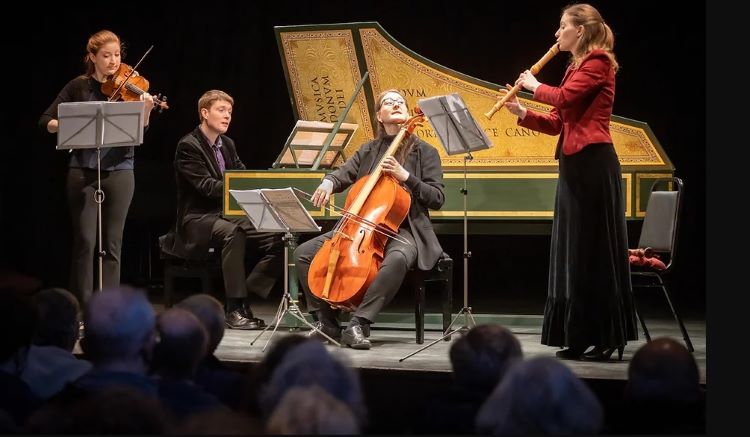(featured in image): Ensemble Hesperi performers
- Mary-Jannet Leith – recorders
- Magdalena Loth-Hill – baroque violin
- Florence Petit – baroque cello
- Thomas Allery – harpsichord
London- based Ensemble Hesperi were formed in 2019, and specialise in baroque chamber music. Projects include several tours and records featuring Scottish-flavoured 18th century music printed and played in London. Their live performances have graced many of the world’s leading early-music festivals, and their recordings of 18th century music are building into a very useful library resource, as well as pleasing the ear with sensitive and beautifully played period instruments.
This album, ‘Full of the Highland Humours’, is informed by current academic research conducted by Scots-born recorderist Mary-Jannet Leith, who is in the final stages of an AHRC-funded doctoral research into Scottish musicians and music-making in 18th century London. As well as well-crafted liner notes, we also have first recordings of work by James Oswald (‘The Sweet Sultan’ from the Airs for Autumn and ‘The Cyclamen’ from Airs for Winter), and Thomas Erskine (movements from ‘Sonata IV’ of his Six Sonatas for 2 Violins and Bass. 1769).
18th century Scotland saw a growth in chamber music played in Lowland Scottish towns and cities such as Edinburgh and Aberdeen, with pleasant melodies from the Scottish traditional music repertoire arranged for small ensembles of amateur musicians to play using the fashionable Italian ‘galant’ style (one or two melody instruments supported by bass continuo instruments). However, it is clear that this development was not simply driven by the tastes of Lowland Scots, but also had a cross-border dimension. For the more ambitious composers, London provided commercial opportunities (James Oswald and Robert Bremner) and/or social networking (Thomas Erskine, the Earl of Kellie), and a steady run of Scottish-flavoured publications left London print-houses for both southern and northern use. The music displayed in this album provides evidence that when Scots like Oswald, Eskine and Bremner arrived in London, they arrive to a city pre-primed with Scottish melody which had, since the later years of the 17th century, found its way into the hearts and music cabinets of Londoners.
Henry Playford was probably the most important of these early London-based publishers whose 17th century printed collections of dance tunes using traditional melodies helped to popularise ‘Scottish’ material in London. The clear melodies and attractive rhythms of the ‘Highland humoured’ music found in Playford’s collections (his is the title that inspires the title of this album) also interested Italian musicians arriving in London, such as teacher, violinist, guitarist Nicola Matteis, oboist Giuseppe Sammartini and violinist Francesco Geminiani, whose creative response to these tunes helped to create the hybrid Scots-Italian ‘drawing-room’ style which featured in the salons of Edinburgh’s music society in the 18th century (see David Johnson, resources below, who originated this term). Music by these non-Scottish market-primers includes here a premiere recording of Playford’s ‘Peggy’s the Prettiest/My Lady Hope’s Scotch Measure’ (1700). Despite their not being Scots, these European musicians also appreciated a picaresque ‘Highland’ title, as is demonstrated by movements from Geminiani’s sonata ‘The Last Time I Came O’er the Moor’ (1749). On this carefully watered ground, Scots natives such as Oswald, Erskine and Bremner found a ready audience for their newly composed music in London.
It is also clear that native-born Scottish musicians in London were musical entrepreneurs. Robert Bremner, whose vigorous theme-and-variations number ‘Hit her on the Bum’ closes this collection, had a career that took him from Edinburgh to London. Bremner was a music teacher as well as purveyor of instruments and sheet music, and when he moved to London in 1762, he continued to supply wealthy Scots north of the border, and the Edinburgh Musical Society, with a steady supply of instruments and fashionable music that combined Italian style with a particular, Scottish, melodic slant. James Oswald’s printed collections were even more copious. Oswald’s title page dedications to the ‘Temple of Apollo’ suggest a circle of subscribers keen to acquire the latest of his many compositions, including the 96 trio sonatas that comprise his ‘Seasons’ concept, nature miniatures themed around plants which flourish at different times of the year.
Leith explains in her notes that Londoners had a rather vague sense of Scotland, and then, as now, a notion of ‘Highland’ identity was applied broad-brush to the Lowlands as well as to the Gaelic-speaking regions to the North and West. Scottish musicians, she suggests, were happy to accept this as a useful marketing positioning tool. Their music, opportunistically crafted for the London marketplace, contributed to a growing sense of common ‘Scottish’ musical identity north of the border as well as in the blunter south. Scotland, musically, was associated with pleasant pastoral dance music, on rural topics such as nature and ballads. This developing repertoire helped to internationalise such ‘markers’ of Scottish music as the Scotch snap and pentatonic gapped scales by the later 18th century.
Alongside recording, Ensemble Hesperi has an excellent track record of regional touring in Scotland, with 2022 seeing them give concerts in Dundee (Wighton Heritage Centre), New Galloway and Aberfoyle. If they visit a town near you in 2023, do catch them!
Further resources
- Ensemble Hesperi, Full of the Highlands Humours, Em Records (2021)
- Ensemble Hesperi website
- David Johnson, Music and Society in Lowland Scotland in the Eighteenth Century (Oxford University Press, 1972)

